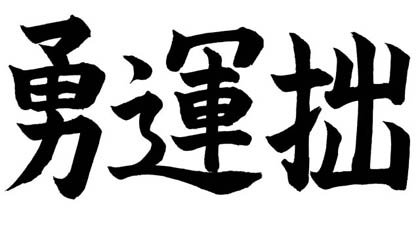16th EIC 2009 – Seminar report
The 16th European Iaido Seminar preceding the competition was lead by a Japanese sensei delegation composed of: Kishimoto sensei – 8th dan Hanshi, Yamazaki sensei – 8th dan Hanshi and Aoki sensei – 8th dan Kyoshi.
Here is a brief list of some of the seminar key points. Those are of course addition/precision to thoses already listed in the ZKR Iaido book. Those main key points come either from the demonstration (Aoki sensei) and explanation (Kishimoto sensei) given to all the participants and remarks made in the 5th dan and up group lead by Kishimoto sensei.
1. MAE
– Do not go too far with your left knee during the seme/furikaburi. At the end of the furikaburi your left knee should be aligned with your right foot heel. Your left knee should not be sticked to your right foot heel.
– At the end of the chiburi the left and right hand should be at the same height.
2. USHIRO 
– In uchiro you are turning off the center line and for nikutsuke you have to get back to the center line. This means that when you are turned your opponent is aligned with your right elbow.
– Cut where the nukitsuke occurred, you have to keep the centerline when doing the seme/furikaburi and the last kirioroshi. A general mistake is to bring the left knee close/sticked to the right heel.
3. UKENAGASHI
– Don’t go too far with your left foot when getting up it should be close to your right knee.
4. TSUKAATE
– The tsuki should be performed parallel with the center line. whe doing the furikaburi just after the tsuki you have to perform what is called hiki nuki using the hips movement to remove the blade from the body at that moment the kissaki is slightly down.
– When performing the tsuki, chibori must be performed with the left hand on the saya pulling it back at the level of the navel
5. KESAGIRI
– You must rotate/reverse smoothly your blade in harmony with the drawing (nukitsuke) of your sword.
6. MOROTETSUKI
– You have to stay on the center line during the entire kata.
– Footwork when doing a 180° is first movinf the your 2 feet to 90° then only moving the left foot into the direction of the enemy
– Again here as there is a tsuki you have to perform hiki nuki
– So there is a clear difference between the first furikaburi (hiki nuki) and the second one which is done with ukenagashi ni
7. SAMPOGIRI 
– Be careful not to go too far with your right foot on the first 90° right cut
– feet should be at 45° and toes from the left foot on the same line as the right foot heel
– When rotating your feet you cannot be on your heel. Never turn on your heels always on the toes
– While going from the first cut to the second -> you will first look at the center line without moving your sword and on the second part of the turn performing ukenagashi as well as on the last cut
8. GANMENATE
– Do the ate between the eyes
– When doing the nukitsuki use the movement of your hips in the saya banare to free the kissaki, after that try to keep the kissaki pointing to your opponent
– when you finish in position before the tsuki you blade should be horizontal and the tsuki will be performed parallel to the starting center line
– make sayabiki with the tsuki
– perform hiki nuki after the tsuki
9. SOETETSUKI
– Synchronize the end of the first cut and the stop of your right foot
– After the tsuki and performing the chiburi try to keep the hasuji and blade angle
10. SHIOGIRI 
– Just after the ate with the tsuka and preparing for the tsuki perform a small left step with your left foot in order to align with your rear opponent
– During the tsuki perform chibori with your left hand on the saya. At the end of the tsuki the blade and the saya should be parallel
11. SOOGIRI
– Right hand should be above your right shoulder in order to perform ukenagashi and the first action nukitsuke should be performed in one action
12. NUKIUCHI
–
GENERAL: When moving/turning only use the toes of you feet. When turning at 180° perform the first 90° only perfoming it with the toes then move the left foot for centerline alignment.
Michaël S. & Kanto Y.



